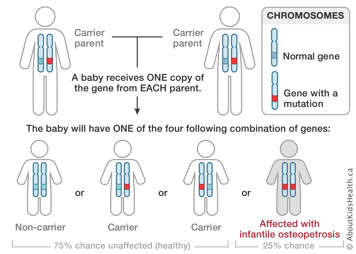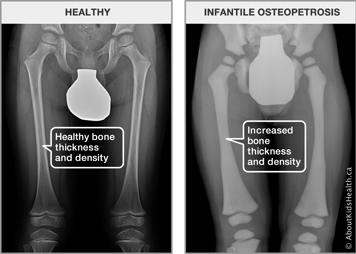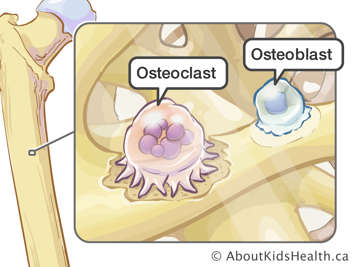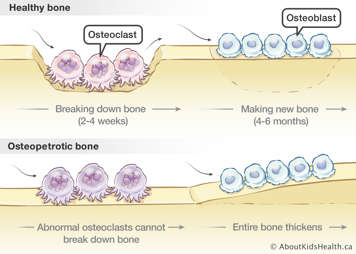What is infantile osteopetrosis?
Infantile osteopetrosis (say: oss-tee-oh-peh-TRO-siss) is a genetic condition that may result in:
- fractures
- short stature (height)
- recurrent infections
- hearing loss
- vision problems
Other names you may hear for this condition are early onset osteopetrosis and malignant infantile osteopetrosis.
This condition is quite rare and is believed to affect about one in 200,000 people.
There are several different forms of osteopetrosis: infantile, juvenile and adult onset. In general, infantile osteopetrosis is the most severe form, while adult-onset osteopetrosis is the mildest form.
Osteopetrosis is a genetic condition
Genetic means related to genes. Each of us inherits our genes from our parents. They provide our bodies with instructions that influence our health, looks and behaviour. In general, each person has two copies of every gene.
Infantile osteopetrosis is caused by a mutation (change) in each copy of a gene. One mutation is inherited from the mother and the other from the father. To date, there are several genes known to cause infantile osteopetrosis, including CLCN7, OSTM1, TCIRG1, TNFSF11, PLEKHM1 and TNFRSF11A.
Infantile osteopetrosis is inherited in an autosomal recessive pattern. This means that:
- A person with infantile osteopetrosis has a mutation in each copy of the gene.
- Each parent carries a mutation in one copy of the gene. The other copy of the gene works normally and because of this, the parent does not show signs and symptoms of infantile osteopetrosis. This person is called a carrier of infantile osteopetrosis.

To learn more about genetics, visit: Genetic counselling.
Diagnosing infantile osteopetrosis
A diagnosis of infantile osteopetrosis is made on the basis of physical examination and X-ray findings. X-rays shows thickening and increased density of bones and bone-within-bone appearance. The diagnosis may be confirmed by DNA testing (blood test).
Infantile osteopetrosis can be diagnosed before birth
Before birth, infantile osteopetrosis can be diagnosed by testing DNA taken from the fetus. This can be obtained in one of the following ways:
- by amniocentesis after the 15th week of pregnancy
- by chorionic villus sampling (CVS) between the 11th and 14th week of pregnancy
These methods are used for high-risk pregnancies, for instance if the parents have another child diagnosed with infantile osteopetrosis.
To be eligible for this testing, the mutations in the gene responsible for causing infantile osteopetrosis must be known. This means that the child with the condition must have genetic testing.
Infantile osteopetrosis may also be diagnosed before birth using ultrasound as early as 14 weeks' gestation. However, it is possible to have a normal ultrasound and still have a baby with infantile osteopetrosis.

Treatment of infantile osteopetrosis
Children with infantile osteopetrosis need attentive, informed care from their parents and health-care providers.
The goals of treatment are:
- to help children with infantile osteopetrosis adapt socially and physically
- to treat the symptoms
Transplantation of hematopoietic stem cells
The most effective treatment option available for infantile osteopetrosis is the transplantation of hematopoietic stem cells. These are the blood stem cells that come from the bone marrow or blood. It is a life-saving procedure with some risks. When successful, it prevents the progression of symptoms and improves bone health. Other problems like vision loss and dental and orthopaedic problems can still happen.
For more information, please see the Blood and Marrow Transplant Resource Centre on AboutKidsHealth.ca.
Calcium supplements
People with infantile osteopetrosis need to have the calcium levels in their blood and urine monitored. If your child's calcium levels are low, your child will need supplements.
Transfusions
Your child should have a complete blood count at least once every year. Depending on the levels, your child may need transfusions of red blood cells and platelets.
For more information, please see the blood transfusion article on AboutKidsHealth.ca.
Treatment of infections
If your child often has infections, your child may need antibiotics.
Treatment of vision problems
Your child should have an eye examination at least once a year. Children with vision problems may need surgery to release the compression of the optic nerve.
Treatment of fractures
Recurrent fractures need management by an orthopaedic surgeon. Special attention is needed because the fracture may take a long time to heal. Patients may need medication for joint pains.
Treatment of dental problems
Children with osteopetrosis are more likely to have dental problems like abscesses, cysts and teeth that take longer to come in. Your child should see a dentist regularly.
How infantile osteopetrosis affects the body
Bone and dental problems
Osteopetrosis is a disorder of bone development in which the bones become thickened. Normally, small areas of bone are constantly being broken down by special cells called osteoclasts, then made again by cells called osteoblasts. This is called bone remodeling, and it helps keep the bones healthy.

In osteopetrosis, the cells that break down bone (osteoclasts) do not work properly, so there is an imbalance between these two functions. This leads to the bones becoming thicker and not as healthy. This can lead to:
- bone fractures
- less overall bone growth, causing short stature
- a thicker skull bone, which may cause teeth to come out later than expected
- larger head size

Problems with bone marrow and blood cells
Bone marrow makes new blood cells. It is found inside the bones. In people with infantile osteopetrosis, because the cells that break down bone do not work properly, the space where the bone marrow is found is smaller or even missing. This means there is less bone marrow, so fewer blood cells are made. This can lead to:
- Anemia because of low red blood cells. Symptoms of anemia include pale skin and lack of energy.
- Bleeding problems because of low platelets. Platelets are blood cells needed for clotting to help stop bleeding.
- Many infections due to low white blood cells. White blood cells are needed to fight infections.
Problems due to thickening of skull bones
The skull bone of people with infantile osteopetrosis is thickened, which can lead to:
- compression of some nerves, causing vision problems and weakness of facial muscles
- narrow nasal sinus, causing chronic nasal congestion
Thickening of the bones of the ear can cause compression of the nerves, resulting in hearing loss.
Calcium and parathyroid levels
Children with infantile osteopetrosis have lower levels of calcium and parathyroid hormone in their blood than normal. This may sometimes lead to increased irritability and seizures if it is not managed. These seizures are often the first sign of infantile osteopetrosis.
Life expectancy
With bone marrow failure and recurrent infections, some babies with infantile osteopetrosis may die before two years of age. Without treatment, most die by the age of ten. Transplantation of hematopoietic stem cells (see below) is the most promising treatment for long-term survival.
Coping with infantile osteopetrosis
Children with infantile osteopetrosis must be followed carefully by a health care team made up of different specialists. Speak to your health care team if you need help or if you are having trouble coping. Dealing with a child with infantile osteopetrosis can be emotionally difficult.
In general, children with visible differences are more likely to have difficulties in school and society. Because of the risk of fractures, your child should avoid high-risk activities and high-impact sports. Encourage your child to participate in activities with other children the same age. As well, try to physically adapt your child's surroundings to support your child and encourage independence.
Genetic counselling for infantile osteopetrosis
Children with infantile osteopetrosis and their families should consider assessment by a geneticist and genetic counsellor. They can help with the following:
- confirming the diagnosis
- discussing the natural history of the disease
- evaluating the risk that future children will also be affected
- discussing available options for managing the disease
Resources and support
The following organizations and sites can offer more information, support and contact with other affected individuals and their families.
The OsteoPETrosis Society (OPETS)
Osteopetrosis Support Trust
www.osteopetrosis-support-trust.org.uk.